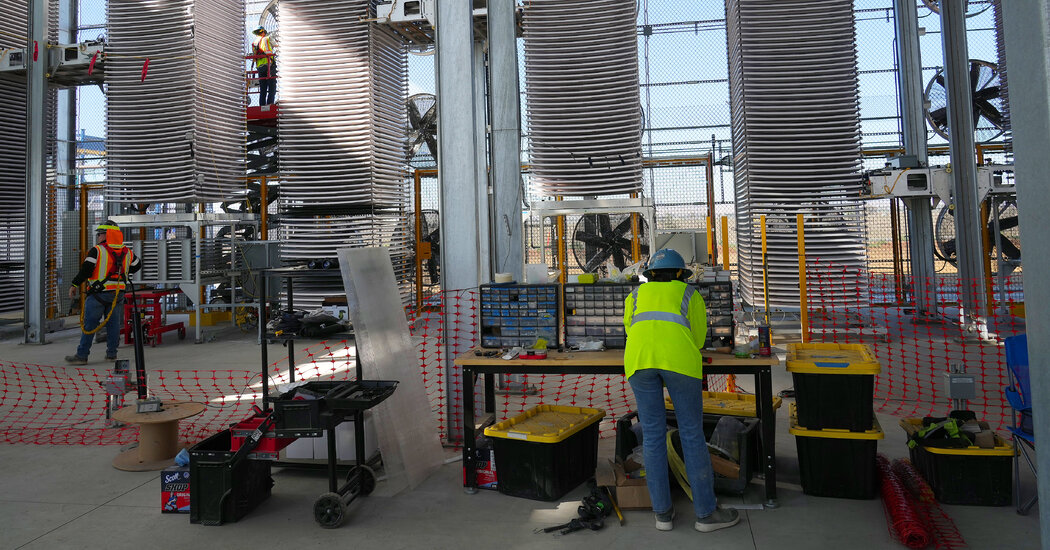Trees do it much cheaper.
Yeah, I mean I think carbon capture is kinda stupid on one level. It’s like an excuse for us to not change our behavior
Yup. It’s a technological antisolution.
An argument is that this is what we should use excess green electricity for. But it does not make sense to run such expensive equipment only a few hours each day. I prefer matching the supply to demand with hydro storage, not to mention that most grids are nowhere near 100% renewable.
If you build enough solar and wind to kick fossils off the grid, they’re going to overproduce at times of peak operation. Rather than wasting that peak production, use it to process CO2.
Also, Canada’s forests burned so hard, they were a net emitter this year. I’m not sure how reliable a carbon sink trees really are as the warming gets worse…
You need nuclear, too. There isn’t enough solar and wind manufacturing and deployment capacity for the foreseeable future to eliminate fossil use. There is no solution to climate change which does not involve significant numbers of new nuclear builds.
Geothermal. It doesn’t matter where you put up those carbon capture facilities. Meaning you could put them in the desert, you could them next to some vulcanos…and so on.
And nuclear builds are a waste of carbon…all that steel and concrete is most of the time not calculated when co2/kwh gets…well, calculated
Wow.
Be more wrong.
Seriously, try; I’ll wait.
Sure is a shame there’s so many scams related to that area. In theory, planting or protecting forests is one of the best things we can do. But in practice? A lot of organizations that claim to protect some area from industrialization are actually protecting an area that was never at risk in the first place. That is, if they didn’t exist, the forest would be unchanged. Others are only protected for short periods of time. https://youtu.be/AW3gaelBypY?si=56uG8zf1iAeJM31H
deleted by creator
Form a Fortune article:
While Heirloom declined to disclose the price tag to build the California facility, the company aims to operate at a cost of $100 per ton of carbon removed by 2030
From a Techwire article:
Heirloom estimates that the current cost of the technology ranges from $600 to $1,000 per ton of CO2 removed.
I could not find any article on how much the carbon cost was to run such a facility and move the raw materials to/from it.
Well, they’re using renewable energy to power it. The limestone looks like it’s just constantly recycled, so it would be just the initial transport there. Their output is tanks of compressed carbon dioxide which is sent to a concrete maker, so it really depends on how far away the concrete maker is. There’s a thing called industrial symbiosis, where manufacturers co-locate so that one factory’s waste easily becomes the factory next door’s input.
I’m not very familiar with all this but shouldn’t we be hiding the CO2 somehow? I feel like concrete is just going to nudge the can down the road until it breaks down in like 50 years
The concrete won’t release the CO2 when it breaks down, since the quicklime in the cement reacts with CO2 to form limestone. The catch is that quicklime is mainly produced by heating limestone to release CO2, so making extra concrete won’t result in net carbon capture. But if the concrete was going to be produced anyway, I suppose it’s better to have it absorb the CO2 sooner rather than later.
Hmm, well that’s less exciting than I had hoped but yeah at least it is something and honestly anything to get new tech funded is probably good overall
While in 50 years it might not be a great building anymore, it will still be a fantastic pile of rubble. Basically landfill, but it can be reused as gravel for new building projects, too.
That all makes sense, thank you!
The concrete frkm the berlin wall is probably being used in some industrial parking lot somewhere.
Roman concrete structures still exist after 2000 years. If you want to “hide” the CO2 somehow, then concrete doesn’t seem like a bad idea.
To earn revenue, the company is selling carbon removal credits to companies paying a premium to offset their own emissions. Microsoft has already signed a deal with Heirloom to remove 315,000 tons of carbon dioxide from the atmosphere.
And this is why direct air capture is a farce right now - any progress they make is literally counter acted by large corporations who will increase their carbon output because they have a contract with a company like this.
Carbon air capture technology paired with 100% clean energy can save the world from a lot of hardship in the near future, but not like this.
I think it’s the opposite. This paves the way to enforce companies to pay to remove the carbon they emit. If this can be profitable then there is room to invest on improvements making it more feasible at large scale.
bro im starting one of these companies
Do you think Microsoft was holding back expanding its business because if carbon output?
They took all the trees and put them in a tree museum.
They paved paradise and put up a parking lot.
Ok Joni
Unfortunately I can’t read the article. What do they do with the carbon once it’s collected? How are these powered? How much power does the collector use compared to how much it collects? If stored, where and how?
At the California plant, workers heat limestone to 1,650 degrees Fahrenheit in a kiln powered by renewable electricity. Carbon dioxide is released from the limestone and pumped into a storage tank.
The leftover calcium oxide, which looks like flour, is then doused with water and spread onto large trays, which are carried by robots onto tower-high racks and exposed to open air. Over three days, the white powder absorbs carbon dioxide and turns into limestone again. Then it’s back to the kiln and the cycle repeats.
“That’s the beauty of this, it’s just rocks on trays,” Mr. Samala, who co-founded Heirloom in 2020, said. The hard part, he added, was years of tweaking variables like particle size, tray spacing and moisture to speed up absorption.
The carbon dioxide still needs to be dealt with. In California, Heirloom works with CarbonCure, a company that mixes the gas into concrete, where it mineralizes and can no longer escape into the air. In future projects, Heirloom also plans to pump carbon dioxide into underground storage wells, burying it.
So they’re using the “limestone -> quicklime -> slaked lime -> limestone” cycle. The kiln must be powered by renewables (otherwise the process is pointless), but it’s a perfectly reasonable capture method.
Storage is slightly less straightforward. Concrete naturally absorbs carbon dioxide over decades, mixing carbon dioxide in during production is just accelerating the inevitable.
Additionally, the reason concrete can absorb carbon dioxide is that cement contains quicklime, which is mainly produced by… you guessed it, heating limestone to release the carbon dioxide! The concrete won’t absorb more carbon dioxide than was released during its production, so making excess concrete is not a solution to CO2 capture. However, if the concrete was going to be produced anyway (and we produce a lot), I suppose it’s slightly better to have it absorb carbon dioxide sooner rather than later.
Pumping carbon dioxide into underground storage wells a more scalable solution, provided that the local geology (olivine?) can absorb the carbon dioxide.
An alternative not discussed in the article is to reduce the carbon dioxide into various feedstock chemicals that we currently derive from fossil fuels. Again, this would need to be powered by renewables otherwise the process is pointless.
You a wonderful. Thank you for this.
You’re welcome!
absolute bullshit, it burns more in carbon to run those machines than it takes out, this is making shit worse at an accelerated pace
You might want to read the article more carefully.
At the California plant, workers heat limestone to 1,650 degrees Fahrenheit in a kiln powered by renewable electricity.
Direct-air carbon capture has its fair share of problems to overcome before it can become a practical solution, but any such process must obviously be powered by renewables. To do otherwise would be pointless.













